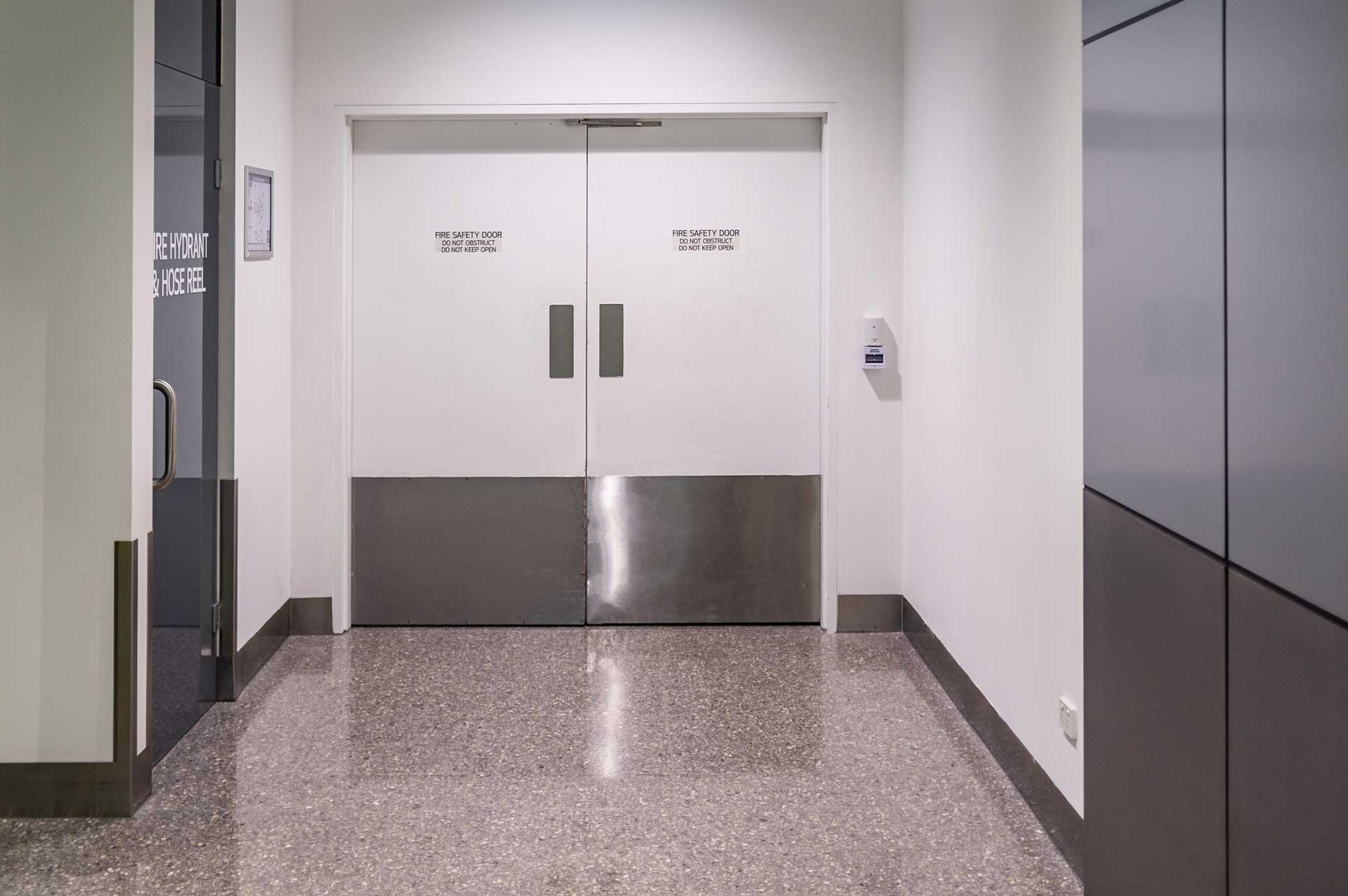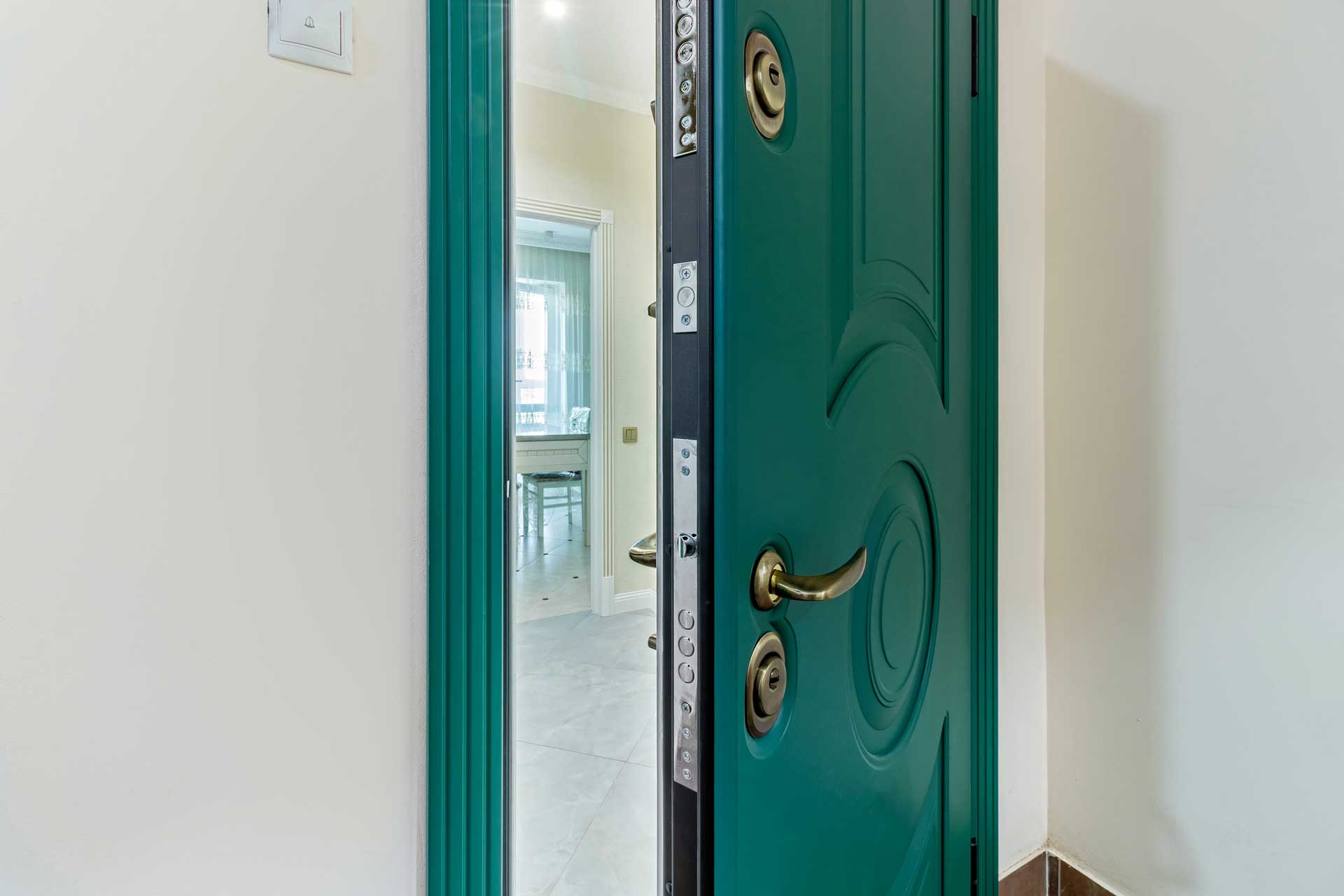As a leading commercial door supplier, we field numerous questions about fire rated doors every day. In fact, fire rated doors are among the most searched for terms on our website. To address this high demand for info, we’ve compiled our most frequently asked questions and more into this comprehensive guide. Read on to learn everything you need to know about fire rated doors, their importance, and how they enhance safety in your commercial spaces.
1. What are fire resistant doors?
Fire resistant doors are specially designed doors that prevent the spread of fire and smoke between compartments within a building. They are constructed to withstand high temperatures and maintain their structural integrity during a fire for a specified period.
2. What are prehung fire resistant doors?
A prehung door implies a hollow core wood door with a wood frame. Per the Ontario Building Code, to get a 20 minute fire rating, you need a 45mm thick door (1 3/4″) and a 38mm frame thickness (1 1/2″). So while a wooden door in a wooden frame can be fire rated, you would be maxed out at a 20 minute rating.
If you need a higher rating but want to stick with a wooden door, you can go with a hollow metal frame and achieve ratings of 20 minutes, 45 minutes, 60 minutes, and 90 minutes.
3. How much glass can a fire resistant door have?
The amount of glass that can be included in a fire resistant door depends on the door’s fire rating and the type of glass used. Fire rated glass, such as wired glass or ceramic glass, is used in these doors and must meet specific fire resistance standards. Typically, the glass area is limited to ensure the door can still perform its fire-stopping function. Check the manufacturer’s specifications for exact limits, but a common maximum is around 100 square inches of glass for a 60-minute rated door.
4. Are hollow core doors fire resistant?
Hollow core doors are not fire resistant. They are lightweight and lack the dense, solid construction needed to slow the spread of fire. Solid core doors, which are filled with fire-resistant materials, are preferable for fire resistance and are often required by building codes for certain areas.
5. What are the different fire ratings for doors?
Fire resistant doors are rated by the amount of time they can withstand fire exposure. Common ratings include 20 (only available on solid core wood), 45, 60, and 90 minutes. These ratings indicate the door’s ability to resist fire and maintain its integrity during that period, helping to prevent the spread of flames and smoke. These doors (and their frame) will come with a fire label stating their rating, which must be applied by a licensed representative.

6. How are fire resistant doors tested?
In Canada, fire resistant doors are tested in accordance with standards such as CAN/ULC-S104, which aligns closely with UL 10C and NFPA 252 used in the United States.
Fire resistant doors in Canada undergo rigorous testing to ensure they meet the required safety standards. Here’s an overview of the testing process:
1.Fire Endurance Test:
- The door assembly is exposed to controlled high temperatures to assess its ability to withstand fire. The test simulates real fire conditions to evaluate how long the door can maintain its integrity and prevent the passage of flames and hot gases.
- The temperature and duration of exposure are specified by the rating being tested (e.g., 20, 45, 60, or 90 minutes).
2. Hose Stream Test:
- After the fire endurance test, the door assembly is subjected to a hose stream test. This involves spraying the door with a high-pressure water stream, simulating the impact of a fire hose.
- The test checks the door’s structural integrity and ensures it can withstand the cooling and mechanical impact of water without significant damage.
3. Additional Tests:
- Temperature Rise: Some fire doors are tested for temperature rise, which measures the heat transfer through the door assembly. This is important for doors installed in areas where occupants might be on the other side during a fire.
- Smoke Control: Fire doors may also be tested for their ability to prevent smoke passage, which is critical for maintaining safe escape routes during a fire.
7. What materials are used in fire resistant doors?
Fire resistant doors are typically made from materials like steel, solid wood, or composite materials that include fire-resistant cores. The frames, hardware and seals around the door are also made from materials that can withstand high temperatures.
8. Can fire resistant doors be customized?
Yes, fire resistant doors can be customized to a certain extent. They can be made to fit various sizes and can include fire rated glass panels, different finishes, and hardware. However, all customizations must comply with fire safety standards to ensure the door maintains its fire rating.
A crucial point to consider with customized doors
Any customization after the fire label is applied – adding a doggy door, for example – would void the fire rating. It’s crucial you make sure you check off all customizations at the time of purchase
9. Do fire resistant doors require special hardware?
Yes, fire resistant doors require special hardware that is also fire rated, including hinges, locks, and handles. The hardware must be able to withstand high temperatures and remain functional during a fire to ensure the door can open and close properly.
10. How do I maintain fire resistant doors?
Regular maintenance of fire resistant doors is crucial to ensure they perform correctly in an emergency. This includes regular inspections to check for damage, ensuring the seals and hardware are in good condition, and testing the door’s operation to make sure it closes and latches properly. Any repairs or replacements must be made with fire rated materials.

11. Where are fire resistant doors required in commercial spaces?
Fire resistant doors are typically required in areas where fire separation is necessary to protect occupants and limit fire damage. This includes stairwells, corridors, mechanical rooms, and between different sections of a building. Building codes and regulations dictate where these doors must be installed.
Conclusion
We hope this guide has answered your questions and provided valuable insights into fire rated doors. Ensuring the safety and compliance of your commercial spaces is paramount, and understanding the role of fire rated doors is a crucial step. If you have any more questions or need assistance in selecting the right doors for your needs, don’t hesitate to contact us. As your trusted commercial door supplier, we’re here to help you every step of the way.